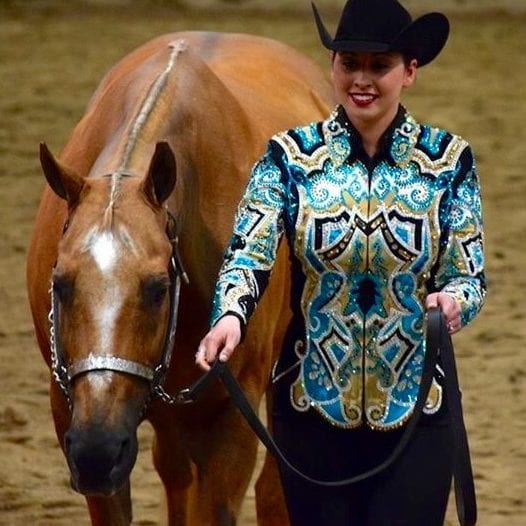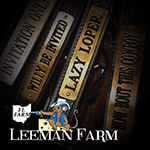Showmanship.
Wikipedia defines showmanship as, “The skill of performing in such a manner that will appeal to an audience or aid in conveying the performance’s essential theme or message.”
And while Wikipedia is using the term in regards to theater, the definition can easily be applied to one of the most difficult classes to master in the show world.
The AQHA Rulebook states that, “The showmanship class shall be designed to evaluate the exhibitor’s ability to execute, in concert with a well groomed and conditioned horse, a set of maneuvers prescribed by the judge with precision and smoothness while exhibiting poise and confidence, and maintaining a balanced, functional and fundamentally correct body position.”
Looking at these two definitions should give exhibitors a solid understanding of what is required in showmanship to be at the top of your game. Not so fast. Some will argue that the vagueness leaves much too much open for the judges’ interpretation. However, most agree that you must be appealing to the audience (judges) and convey a performance (pattern) that exhibits precision, smoothness, poise, and confidence.
Certainly, no easy task.
Appearing too animated, fake, poorly presented or rushed will have an affect on your overall score in showmanship. GoHorseShow sat down with AQHA Professional Horsewoman, Barbie Evans of Elizabeth, Colorado. Barbie offers some great advice on how to boost your showmanship scores.
1) Be Connected With Your Horse
If you watch the industry’s top showmanship competitors, it immediately becomes clear that those exhibitors know their horse inside and out. That is why it is so beautiful to watch them perform.
“Judges want to see you be in sync with your horse and want you to demonstrate that you know that horse and how to read them,” said Evans. “If you know your horse that intimately, they also know you that intimately, and it really just is a beautiful thing to watch. Those are the exhibitors that earn the highest scores.”
2) A Well-Shaped Hat Really is Important
“When a judge looks over to the cone, the first thing they see is the exhibitor’s hat,” she said. “A well-shaped hat sends a good message to the judge that the exhibitor is serious about his/her craft and knows what they’re doing. The judge instantly has you on their radar as being able to perform a pattern in the 80-90 point range. A poorly shaped hat just doesn’t send the same message.”
3) The Same Goes for Well-Fitting Pants
Evans said, “Frequently people either have their pants too tight and too short or too loose and too short and this is all distracting to the judge. A good rule of thumb is that when you run, you should just barely be able to see the sole of your boot. Pants need to be complementary to the person’s body shape and size. They need to be clean and creased and the color needs to be age appropriate. And please, no panty lines.”
4) Run Like a Normal Human Being
There are a lot of names for how exhibitors run in the showmanship that we won’t get into here, but the bottom line is folks, be natural.
Evans said, “You need to stay connected to your body and your horse when you run. You should be upright with everything pulled in (shoulders, rear end, chest, etc.) and your foot fall should match the horse’s movement. These animated runs we see don’t blend in with the horse and the goal in showmanship is to show your horse, not so much yourself. So, your movement needs to be natural and shows that you and the horse are in tune with one another.”
5) Smile Normally, Too
Remember we are showing horses, we aren’t pageant queens, so ditch the fake smile that is plastered on your face for the whole pattern and give the judges more of who you really are.
“Judges get the impression that the exhibitor isn’t really focused or tuned into their horse when they smile constantly,” said Evans. “As you approach the steward (or judge) for your set up, a nice friendly smile as you make eye contact is all you really need. Otherwise, just a pleasant look on your face is sufficient.”
6) Your Hands Should Be A Prop
“Using your hands too much, or having super busy hands is distracting and isn’t a pleasant picture,” said Evans. “I like for exhibitors to have natural looking hands, where the right is slightly higher than the left, but the overall picture should look like the exhibitor is holding a tray or a shelf and nothing is going to spill. Your hands should be a prop to finish off the complete picture and nothing more.”
7) Don’t Block Your Horse When You Back
Standing directly in front of the horse is considered a severe fault according to the AQHA Rulebook, yet countless exhibitors still move to that position before backing their horse.
Evans said, “Remember, showmanship is about showing your horse and if you stand directly in front of them, we can’t see your horse anymore. An exhibitor should always be off to the side and present their horse to the judge, even while backing. You should be able to maintain this position and still back your horse smoothly and in a straight line.”
8) Strive For Fast, Clean Set-Ups
If two exhibitors have nearly identical patterns, the one thing judges will usually go to “break the tie” is the set up.
“You always want to strive for a 1-2 step set up,” said Evans. “And the exhibitor with the least amount of steps will earn more credit. If your horse happens to be having a great day and stops square, leave them alone.”
(The AQHA Rule Book states that an exhibitor does not need to reset a horse that stops square. So don’t.)
9) Flowing, Correct Pivots Earn the Most Credit
“A slower, more correct pivot will earn more credit than a fast, sloppy one,” said Evans.
The thing exhibitors need to remember about pivots is that the end of the pivot is just as important as the beginning, so if you come out of a pivot with a shoulder or hip sticking out, you’ve just lowered your score.
Evans also added, “It is also important for the pivot to be rhythmic and for your footfall to match the horse.”
10) Present a Finished Picture
“A good showmanship exhibitor walks into that pen and tells the judge through their appearance and performance that they ARE the winner,” said Evans. “In showmanship, the winner is usually the easiest to see.”
That being said, make sure your number is on straight, your hair is in a neat bun (and your head is loaded with hairspray), and you have some complementary makeup on that shows your face.
As with any class, sometimes the smallest things make the biggest difference. Showmanship is no exception, and because of the nature of the class, the smaller things can be the deciding factor. So make sure you give judges the impression that you are ready to win every time you step into the pen.








